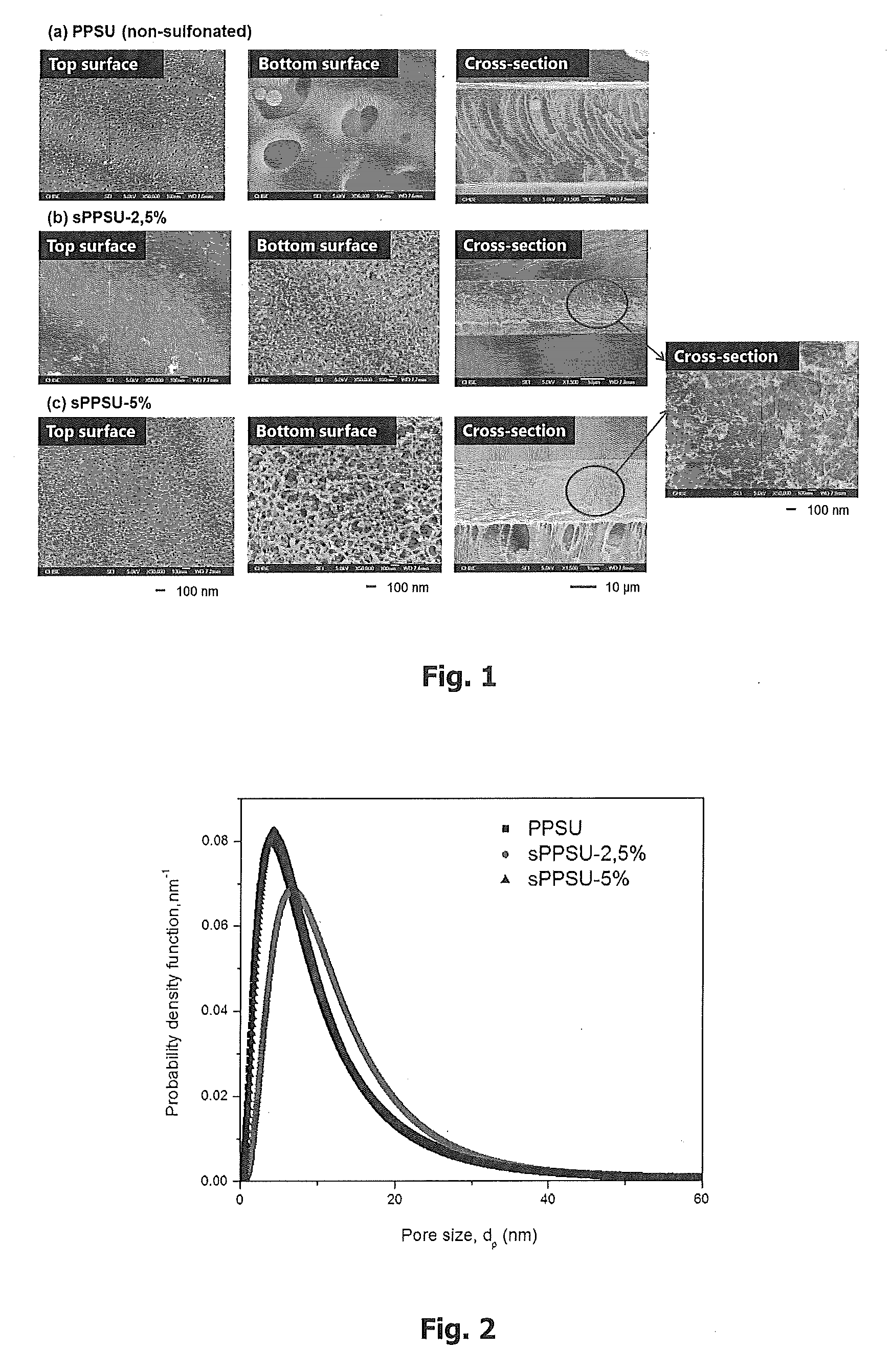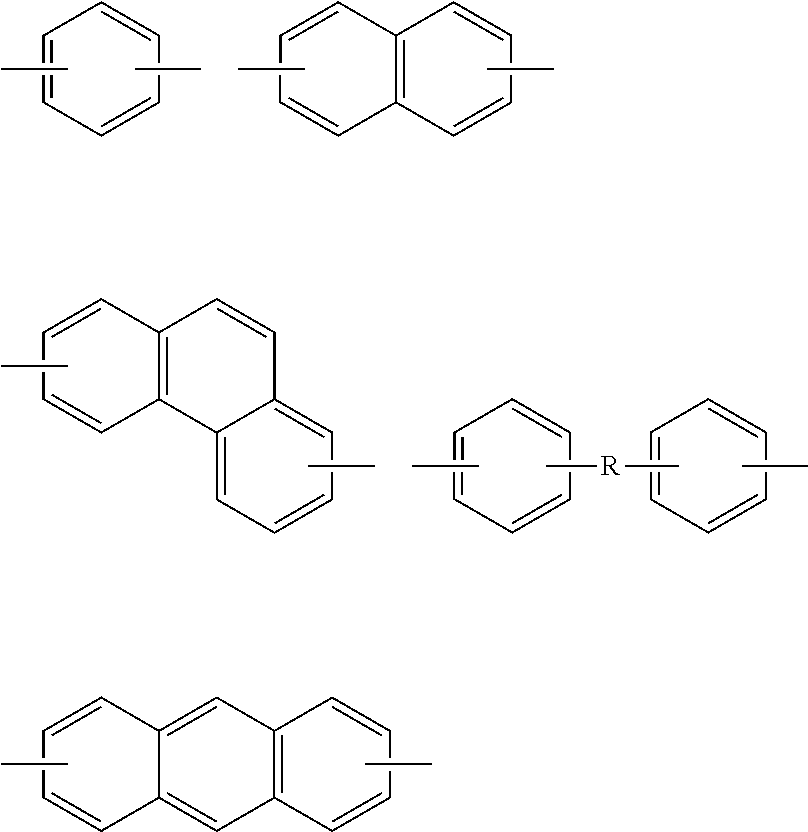Ultrafiltration membranes fabricated from sulfonated polyphenylenesulfones
a technology of polyphenylenesulfone and ultrafiltration membrane, which is applied in the direction of membranes, filtration separation, separation processes, etc., can solve the problems of poor wettability, macrovoid formation, fouling tendency, etc., and achieves enhanced separation performance, reduced fouling tendency, and high water permeability
- Summary
- Abstract
- Description
- Claims
- Application Information
AI Technical Summary
Benefits of technology
Problems solved by technology
Method used
Image
Examples
example 1
Preparation of Membrane Substrate Polymers
a) sPPSU 2.5%
[0100]In a 4 l HWS-vessel with stirrer, Dean-Stark-trap, nitrogen-inlet and temperature control, 1.99 mol Dichlorodiphenylsulfone (DCDPS), 2.00 mol 4,4′-Dihydroxybiphenyl (DHBP), 0.05 mol 3,3′-Di-sodiumdisulfate-4,4′-dichlorodiphenylsulfone and 2.12 mol Potassiumcarbonate (Particle size 36.2 μm) are suspended under nitrogen atmosphere in 2000 ml NMP. Under stirring the mixture is heated up to 190° C. 30 l / h nitrogen is purged through the mixture and the mixture is kept at 190° C. for 6 h. After that time 1000 ml NMP are added to cool down the mixture. Under nitrogen the mixture is allowed to cool down below 60° C. After filtration the mixture is precipitated in water which contains 100 ml 2 m HCl. The precipitated product is extracted with hot water (20 h at 85° C.) and dried at 120° C. for 24 h under reduced pressure.
[0101]Viscosity number: 88.7 ml / g (1 wt.- / vol % solution in N-methylpyrrolidone at 25° C.).
[0102]The content of ...
example 2
Fabrication of Fully Sponge-Like and Hydrophilic UF Membranes from sPPSU 2.5% and sPPSU 5%
[0106]sPPSU 2.5% and sPPSU 5% were synthesized as described above in example 1 and following to the synthesis route developed by McGrath et al. [14].
[0107]N-methyl-2-pyrrolidone (NMP) from Merck and ethylene glycol (EG) from Sigma Aldrich were employed as the solvent and additive, respectively, in the fabrication of UF membranes. The composition of each dope solution was polymer / EG / NMP (wt %)=13 / 16 / 71.
[0108]The casting solutions were allowed to degas overnight prior to casting onto a glass plate with a casting knife of 100 μm in thickness. The as-cast membranes were then immersed into a water coagulation bath immediately at room temperature and kept for 1 day to ensure complete precipitation.
[0109]During the precipitation process, it can be observed that UF membranes cast from sPPSU materials with 2.5 and 5 mol % DCDPS show slower precipitation rates as compared to that of non-sulfonated PPSU m...
example 3
UF Performance Testing of sPPSU-2.5% sPPSU-5% and PPSU Membranes
[0113]The above-mentioned fabricated flat sheet membrane substrate was first tested to measure its pure water permeability (PWP) (in L / m2·bar·hr) by an ultrafiltration membrane permeation cell with a sample diameter of 5 cm [17, 18].
[0114]PWP=QA·ΔP(1)
where Q is the water permeation volumetric flow rate (L / h), A is the effective filtration area (m2), and ΔP is the trans-membrane pressure (bar).
[0115]Subsequently, the membrane was subjected to neutral solute (polyethylene glycol (PEG) or polyethylene oxide (PEO)) separation tests by flowing them through the membrane's top surface under a pressure of 25 psi (1.72 bar) on the liquid side. The concentrations of the neutral solutes were measured by a total organic carbon analyzer (TOC ASI-5000A, Shimadzu, Japan). The measured feed (Cf) and permeate (Cp) concentrations were used for the calculation of the effective solute rejection coefficient R (%):
[0116]R=(1-CpCf)×100...
PUM
| Property | Measurement | Unit |
|---|---|---|
| thickness | aaaaa | aaaaa |
| molar ratio | aaaaa | aaaaa |
| thickness | aaaaa | aaaaa |
Abstract
Description
Claims
Application Information
 Login to View More
Login to View More - R&D
- Intellectual Property
- Life Sciences
- Materials
- Tech Scout
- Unparalleled Data Quality
- Higher Quality Content
- 60% Fewer Hallucinations
Browse by: Latest US Patents, China's latest patents, Technical Efficacy Thesaurus, Application Domain, Technology Topic, Popular Technical Reports.
© 2025 PatSnap. All rights reserved.Legal|Privacy policy|Modern Slavery Act Transparency Statement|Sitemap|About US| Contact US: help@patsnap.com



